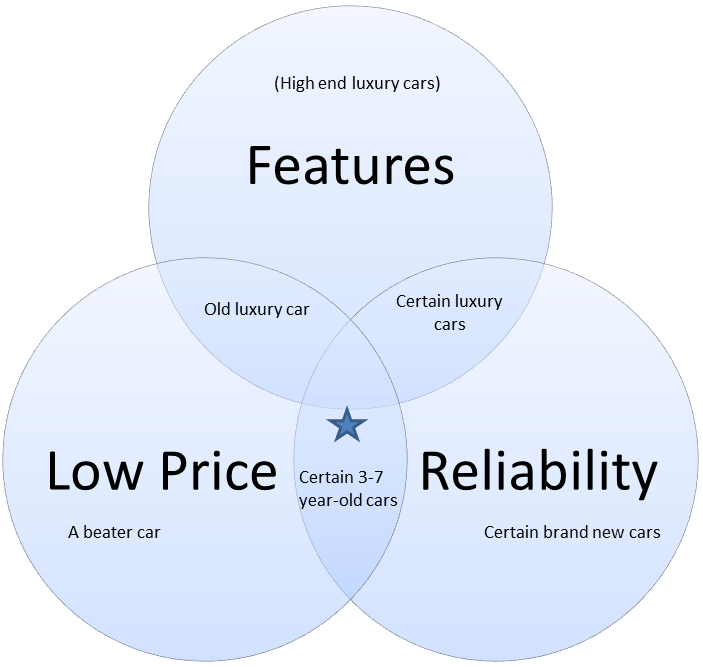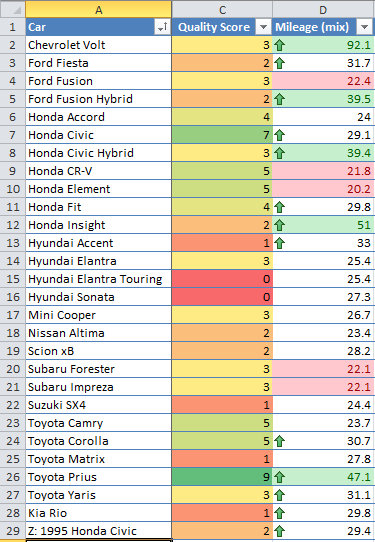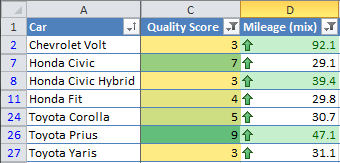Buy a Car With Data - Part 1
13 February 2012
In this set of blog posts, I will cover my experience in buying a car using data. I’ll go over some of the advantages, like ignoring all of the lies marketing.
Background
We like reliable steeds
My wife, Kate, and I were perfectly content to drive her car, a 1995 Honda Civic. It never gave us any trouble…until it died last December. Then we needed a replacement.
After mourning the passing of our reliable steed, we decided we did not care about specific car brands or models. We cared about features. Our goal was to buy a car with features we care about, for the best price. Our first step: decide what functionality we wanted most.
Know Thyself
We spoke for an hour, and made a list of desired features. This was the place for each of us to say what we thought was important; other people will have different results.
| Must-Have Feature | Reason |
| Better than 27 mpg city, 37 mpg highway | We like the environment. That is what our old car did. |
| Highly reliable | We like low maintenance costs |
| Good crash test ratings/data | We like safety |
| Lasts at least 5 years | The cheapest car is the one you already own |
| Anti-lock brakes & air bags | We like safety |
| Enough space for a baby seat | We'll need that in a few years |
| Cruise control | Makes road trips easier |
| Audio line-in jack, for iPods | We like music |
| At least 10 sq ft of storage space in the trunk | Necessary for camping trips |
| Range of at least 500 miles per day | Necessary for road trips |
| Nice to Have Feature | Reason |
| CD player, radio, and good speakers | We like music |
| Sunroof | We live in Seattle |
| Power windows, door locks | We're lazy |
| Leather seats | Easier to clean child-induced messes |
| Lasts 10+ years | We're really cheap |
Now that we knew our goals, it was time to learn the game.
Know Thy Enemy
Both of us have heard horror stories about the car buying experience. Neither of us had done this before. So it was time to learn. We used our favorite resource: The Internet. A few web searches found dozens of articles discussing the best ways to buy a car. We read through the top 30 and took notes. From that we made a list of best practices when buying a car.
We also found there is a balance between features, price, and reliability:
Lessons Learned
- Best practices for car shopping
- Things to avoid when car shopping
- Get a used car if you want a deal
Round 1: Find Good Car Models
Armed with our list of features, we started looking at different car models made since 2004. I found Edmunds.com and CarAndDriver.com to be particularly helpful here. A couple hours’ web browsing found 27 models that fit our criteria. Now the fun part: data!
Our top criteria were reliability and fuel efficiency. So, we documented each car’s gas mileage, and created an ‘Internet score’ that counted how often each model was included in articles about ‘the most reliable used cars’ or ‘the top 10 quality cars by BigCarWebsite’. A little Excel conditional formatting, and voila! We ended up with this:
We removed cars with bad gas mileage (less than 29 mpg combined), and with an Internet score of less than 3 (not reliable enough). That left 7 cars.
Next, we compared each car’s specs with our list of must-have features. This led to 4 more disqualifications:
- Chevy Volt - far too expensive
- Honda Civic Hybrid - the rear seat does not fold down
- Toyota Yaris - can’t easily fit a child seat. It has too little storage space.
- Toyota Corollas - no cruise control
We were left with 3 cars: the Honda Fit, the Honda Civic, and the Toyota Prius. They became our short list. Now it was time for test drives.
Round 2: Test Drives!
Test driving a car isn’t about data. Driving a car is subjective. If we think about why a car feels a certain way, a test drive can provide a wealth of information. One day, 3 test drives and 2 auto dealerships later, Kate & I came away with some pros and cons for each car, but we liked all 3 of them.
Additional web research showed that none of our cons was justified. The only lesson was realizing that a Prius is very mechanically complicated. So we should only look at Priuses (Prii?) with warranties.
In our next post, we will analyze specific cars for sale, looking for the best deals.
PermalinkSQL Saturday Vancouver - Agile Database Development
11 January 2012
 . I am honored to say that I have been chosen to give an updated version of my presentation Database Development: Keep it Agile, Not Fragile at SQL Saturday 114, in Vancouver, BC, on March 17th, 2012.
. I am honored to say that I have been chosen to give an updated version of my presentation Database Development: Keep it Agile, Not Fragile at SQL Saturday 114, in Vancouver, BC, on March 17th, 2012.
The world of software development is accelerating. The time between a business idea and its release date is shrinking. That means developers, business staff, and IT personnel need to do more iterative (a.k.a. agile) design, development, and deployments. Agile development for most types of systems is a known quantity. Agile development for databases is harder, and the best practices are more obscure.
Having done a few hundred database releases in an agile fashion, I’ll be presenting best practices, anti practices, tips, tricks, demos, and scripts you can use. Don’t miss out!
Permalink


